Subject: Black-on-Black Plate Signed as Marie and Santana
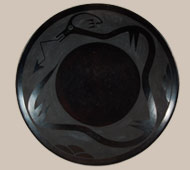 Maria and Julian Martinez certainly established blackware pottery as a collectible for many generations to come. When Julian passed away in 1943, Maria was left with no one to paint the designs on her exquisite masterpieces. It was then that Santana Martinez, wife of Maria's oldest son, Adam, stepped in and began painting the designs for her mother-in-law. Santana continued doing this until 1956, when Maria's other son, Popovi Da, started painting for his mom.
Maria and Julian Martinez certainly established blackware pottery as a collectible for many generations to come. When Julian passed away in 1943, Maria was left with no one to paint the designs on her exquisite masterpieces. It was then that Santana Martinez, wife of Maria's oldest son, Adam, stepped in and began painting the designs for her mother-in-law. Santana continued doing this until 1956, when Maria's other son, Popovi Da, started painting for his mom.
Santana came from a family of very famous potters and painters. Her mother was Alfonsita Martinez Roybal, an accomplished potter. Her uncle, Crescencio Martinez, was the first painter from San Ildefonso and one of its finest artists. He was married to Maria's sister, Maximiliana. Santana's aunt was Tonita Martinez Roybal who has been considered one of the finest potters at San Ildefonso and probably the closest as a competitor to Maria. So we see that Santana came from a family of extremely talented artists and she, herself, proved to be one too.
This is a very early Maria and Santana Black-on-black plate. It was purchased in 1943, the year Julian passed away and the first year that Santana painted for Maria. It is signed Marie + Santana, a signature used from 1943-1956. Note the thinness of the Avanyu (water serpent), compared to those painted later by Santana. There is a buff-on-red plate painted by Santana illustrated in Spivey's book, plate 68, with a similar thin Avanyu design.
Condition: This plate is in very good condition with some minor scratches consistent with what one would expect on a piece over 65 years old.
Provenance: Michael Hering, former Director, Indian Art Research Center, School of Advanced Research, Santa Fe
Note: Noted authority Richard Spivey sent me the following comment which we are pleased to print:
Maria retired from pottery making in October 1970; she made no pottery for the commercial market after that time. Santana did not pick up on painting Maria's pottery after Po's death since Maria was no longer potting.
Subject: Black-on-Black Plate Signed Marie + Santana
Artist / Potter: Maria Martinez 1887-1980
Category: Contemporary
Origin: San Ildefonso Pueblo
Medium: Native Materials
Size: 14" diameter
Item # 22974
Subject: Black-on-Black Plate Signed Marie + Santana
 Maria and Julian Martinez certainly established blackware pottery as a collectible for many generations to come. When Julian passed away in 1943, Maria was left with no one to paint the designs on her exquisite masterpieces. It was then that Santana Martinez, wife of Maria's oldest son, Adam, stepped in and began painting the designs for her mother-in-law. Santana continued doing this until 1956, when Maria's other son, Popovi Da, started painting for his mom.
Maria and Julian Martinez certainly established blackware pottery as a collectible for many generations to come. When Julian passed away in 1943, Maria was left with no one to paint the designs on her exquisite masterpieces. It was then that Santana Martinez, wife of Maria's oldest son, Adam, stepped in and began painting the designs for her mother-in-law. Santana continued doing this until 1956, when Maria's other son, Popovi Da, started painting for his mom.
Santana came from a family of very famous potters and painters. Her mother was Alfonsita Martinez Roybal, an accomplished potter. Her uncle, Crescencio Martinez, was the first painter from San Ildefonso and one of its finest artists. He was married to Maria's sister, Maximiliana. Santana's aunt was Tonita Martinez Roybal who has been considered one of the finest potters at San Ildefonso and probably the closest as a competitor to Maria. So we see that Santana came from a family of extremely talented artists and she, herself, proved to be one too.
This is a very early Maria and Santana Black-on-black plate. It was purchased in 1943, the year Julian passed away and the first year that Santana painted for Maria. It is signed Marie + Santana, a signature used from 1943-1956. Note the thinness of the Avanyu (water serpent), compared to those painted later by Santana. There is a buff-on-red plate painted by Santana illustrated in Spivey's book, plate 68, with a similar thin Avanyu design.
Condition: This plate is in very good condition with some minor scratches consistent with what one would expect on a piece over 65 years old.
Provenance: Michael Hering, former Director, Indian Art Research Center, School of Advanced Research, Santa Fe
Note: Noted authority Richard Spivey sent me the following comment which we are pleased to print:
Maria retired from pottery making in October 1970; she made no pottery for the commercial market after that time. Santana did not pick up on painting Maria's pottery after Po's death since Maria was no longer potting.
Subject: Black-on-Black Plate Signed Marie + Santana
Artist / Potter: Maria Martinez 1887-1980
Category: Contemporary
Origin: San Ildefonso Pueblo
Medium: Native Materials
Size: 14" diameter
Item # 22974
Subject: San Ildefonso Tall Neck Maria Martinez Jar
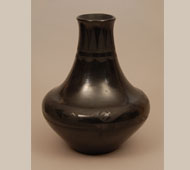 Maria Martinez was a very talented potter. She had the creativeness to devise numerous vessel shapes and each was visually superior to the shapes of others. This tall-neck jar is a good example. The lower body is large and visually provides a stable base to the tall slender tapering neck. This style neck on a body of lesser volume would not be as pleasing-a fact Maria understood.
Maria Martinez was a very talented potter. She had the creativeness to devise numerous vessel shapes and each was visually superior to the shapes of others. This tall-neck jar is a good example. The lower body is large and visually provides a stable base to the tall slender tapering neck. This style neck on a body of lesser volume would not be as pleasing-a fact Maria understood.
This jar is signed Marie, which would place its date in the 1920s and would indicate that it was decorated by Julian. The neck design is a series of clouds and an Avanyu encircles the widest area of the body, designs that fit the shape of the vessel beautifully.
Condition: structurally in excellent condition. There are some slip cracks but they appear only to be slip cracks and they do not penetrate the clay body.
Provenance: from the collection of a Santa Fe family
Recommended Reading: The Legacy of Maria Poveka Martinez by Richard Spivey
Subject: San Ildefonso Tall Neck Maria Martinez Jar
Artist: Maria Martinez 1887-1980
Category: Contemporary
Origin: San Ildefonso Pueblo
Medium: native clay
Size: 12-1/4" tall x 10-1/4" diameter
Item # C3281
Subject: Historic Mojave Clay Doll Figurine
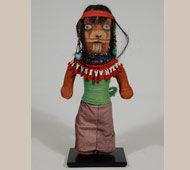 The land of the Mojave, the most northern of the Yuman tribes, stretched from Black Canyon to the Picacho Mountains below today's Parker Dam (California and Arizona border), straddling the Colorado River.
The land of the Mojave, the most northern of the Yuman tribes, stretched from Black Canyon to the Picacho Mountains below today's Parker Dam (California and Arizona border), straddling the Colorado River.
The Mojave could be a fierce people willing to protect their land, and willing to venture far from it. They traveled to the Pacific Coast, becoming proficient traders. They exchanged with coastal tribes surplus crops for goods they desired and valued, such as shells.
And back at home along the banks of the river, they made pottery from sedimentary clay and crushed sandstone. The material was coiled into shape, dried, painted and fired in either open pits or rudimentary kilns. They created pots, bowls, ladles and dishes decorated with geometric designs. And the women took the crafts further by making unique pottery dolls for the children, dressing and decorating them like people, complete with human hair. The art of tattoo was important to the Mojave. They tattooed their faces with lines and dots-a cosmetic, fashionable practice.
The women decorated the faces of the dolls with traditional tattoo patterns worn by the adults. They dressed them in traditional clothing including elaborate earrings and beadwork, as illustrated in this one. A metal stand has been manufactured for secure display of the doll.
Condition: really in very good condition with some fading of the purple skirt but nothing else of significance.
Provenance: from the collection of Chuck and Jan Rosenak, renowned collectors and authors of Navajo Folk Art.
Recommended Reading: Mojave Pottery, Mojave People: The Dillingham Collection of Mojave Ceramics by Jill Furst
Subject: Historic Mojave Clay Doll Figurine
Potter Unknown
Category: Historic
Origin: Mojave
Medium: clay, paint, fabric, beads
Size: 9-3/4" tall
Item # 25599
Subject: Skunk Unknowingly Sharing Bear’s Watermelon
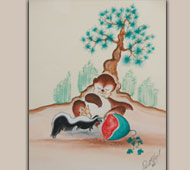 Paul Vigil is the son of famous Tesuque Pueblo artist Tomas Vigil (1889-1960). He primarily paints single figure pueblo dancers and animals. In this painting, he shows a contented brown bear that has fallen asleep after filling himself with watermelon. While he naps, a skunk helps himself to the watermelon.
Paul Vigil is the son of famous Tesuque Pueblo artist Tomas Vigil (1889-1960). He primarily paints single figure pueblo dancers and animals. In this painting, he shows a contented brown bear that has fallen asleep after filling himself with watermelon. While he naps, a skunk helps himself to the watermelon.
The painting is signed in lower right and dated 1962. It is double-matted with acid-free mats and framed in an oak-color wood frame.
Condition: appears to be in original condition but has not been examined out of the frame. It is framed using acid-free mats so it is probably in original condition.
Provenance: from a gentleman in California
Subject: Skunk Unknowingly Sharing Bear's Watermelon
Artist: Paul Vigil, Tesuque Pueblo
Category: Paintings
Origin: Tesuque Pueblo
Medium: watercolor on paper
Size: 8-1/4" x 6-1/2" image; 13" x 11-1/4" framed
Item # C3381D
Subject: Diné Sterling Silver and Turquoise Earrings
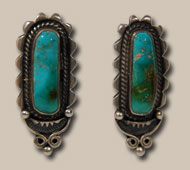 This pair of earrings appears to be from the last half of the 20th century. Each is stamped with a capital R enclosed by a capital D. I have not yet determined to whom those initials belong. A long oval and domed beautiful blue turquoise stone with golden copper matrix is set in a silver bezel that is mounted on silver stock scalloped on its edges. Twisted silver rope encircles the stone. The earrings are for pierced ears.
This pair of earrings appears to be from the last half of the 20th century. Each is stamped with a capital R enclosed by a capital D. I have not yet determined to whom those initials belong. A long oval and domed beautiful blue turquoise stone with golden copper matrix is set in a silver bezel that is mounted on silver stock scalloped on its edges. Twisted silver rope encircles the stone. The earrings are for pierced ears.
Condition: original condition
Provenance: from the collection of a Santa Fe resident
Biography: Jean Sahme Nampeyo (1948 - )
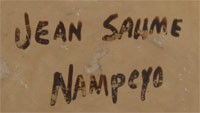 Jean is a daughter of Priscilla Namingha Nampeyo and the granddaughter of Rachel Namingha Nampeyo. Her great grandmother was Annie Healing Nampeyo, whose mother was Nampeyo of Hano. Jean has seven siblings, all of whom are potters or Katsina doll carvers. Her brothers and sisters are Nyla Sahmie, Rachel Sahmie, Bonnie Chapella, Randy Sahmie, Andrew Sahmie, Foster Sahmie and Finkle Sahmie. Jean is the only member of the family who signs her name Sahmerather than Sahmie.
Jean is a daughter of Priscilla Namingha Nampeyo and the granddaughter of Rachel Namingha Nampeyo. Her great grandmother was Annie Healing Nampeyo, whose mother was Nampeyo of Hano. Jean has seven siblings, all of whom are potters or Katsina doll carvers. Her brothers and sisters are Nyla Sahmie, Rachel Sahmie, Bonnie Chapella, Randy Sahmie, Andrew Sahmie, Foster Sahmie and Finkle Sahmie. Jean is the only member of the family who signs her name Sahmerather than Sahmie.
Jean has a very artistic style of creating designs on pottery. She does not hesitate to select parts of traditional Sikyatki design elements and to arrange them in a most artistic and pleasing manner.
Subject: Bronze Sculpture of Eototo and Aholi Katsinas "Morning Prayers"
On another planet at another time, some say, Eototo and Aholi were inseparable friends. The two personalities retain that proximity as Hopi Katsinas and continue to work together at ceremonies that link the earth and its inhabitants with other forces in the universe.
Eototo is chief among the katsinas. With his second-in-command Aholi, he played a historically vital role in the great 17th century pueblo revolt. Quintessentially Hopi, each nonetheless possesses attributes or characteristics that seem to echo those of other religions' saints or priests. Aholi's cone-shaped head and staff recall the appearance of Christian bishops in ceremonies and Aholi's repeated chanting of his own name resembles the rhythms of a different liturgy. These non-coincidental cultural reverberations blend mockery and tribute with an overwhelming Hopi sense of the inter-connectedness of all things.
The limited edition bronze sculptures of Lowell Talashoma, Sr. are the manifestations of an artistic eye and vision that spans two cultures, for Lowell is unusual in having spent many of his childhood years in the care of foster parents who raised him in a mainstream Mormon home. Becoming Hopi meant for Lowell accepting a new reality and set of beliefs as well as coming to understand the traditions, ceremonies, languages and social customs implicit in his choice. Giving form to this historically-rich culture is a task Lowell set for himself with pleasure and excitement; what is ancient and inherently true to the Hopi people is newly rediscovered and revered through Lowell's dawning awareness of what it is to be Hopi.
Each form and figure tells a story as does the process Lowell employed in its creation. His images were inspired by Hopi beliefs and were "liberated" from cottonwood root-the Hopi traditional carving material-through his vision of what lies within. Although he could have worked faster in preparation for bronzing by using wax or clay, Lowell preferred to interact with the wood, a material he respected for its life character. The castings made from his carvings via the lost wax method retain that spirit.
This bronze sculpture of Aholi and Eototo Katsinas was cast in 1982 by the lost wax method in an edition of 35 of which this is number 1.
Condition: original condition
Provenance: from the estate of a California family. There are six bronze katsina sculptures by Lowell Talashoma in this estate which all are numbered 1 of 35. The family apparently had connections with the foundry to acquire the first casting of each of the six. The others which are available are shown below in related items of interest.
Recommended Reading: Beyond Tradition: Contemporary Indian Art and Its Evolution [Paperback Edition] by Lois Jacka, et al.
Subject: Bronze Sculpture of Eototo and Aholi Katsinas "Morning Prayers"
Artist: Lowell Talashoma, Sr. (1950-2003)
Category: Bronze
Origin: Hopi Pueblo
Medium: bronze casting, wood pedestal
Size: 19-1/2" tall x 16" long x 6-3/4" wide including pedestal
Item # C3365F
Subject: Hopi Tewa Laguna Polychrome Jar
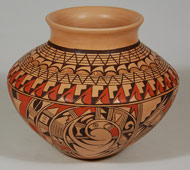 Roberta Youvella Silas was born in 1939 and began making pottery in 1965. She was the daughter of Pauline Youvella (Laguna Pueblo) and Roy Youvella (Hopi-Tewa). No one in her family made pottery, so she learned to do so by working with Helen Naha (Feather Woman).
Roberta Youvella Silas was born in 1939 and began making pottery in 1965. She was the daughter of Pauline Youvella (Laguna Pueblo) and Roy Youvella (Hopi-Tewa). No one in her family made pottery, so she learned to do so by working with Helen Naha (Feather Woman).
Silas lived in the village of Polacca at First Mesa, where she was able to see many examples of ancient Sikyatki pottery in the form of pot shards. She incorporated the ancient pottery designs from these shards into her work. Several potters of Hopi-Tewa lineage developed a wonderful design concept that is in variance with the more traditional Sikyatki-revival designs used by the Nampeyo family, yet it is based on the same origin. Roberta Silas was one of these who mastered the design concept.
This is an extremely well made medium-sized jar. It is nicely formed and painted with a precise hand. The ancient Sikyatki designs are a reminder of the continuity of pottery making on the Hopi mesas. It is signed by the potter on the bottom as follows: Roberta Youvella Silas Laguna Tewa. Silas was proud that she had connections to two pueblos and illustrated this by signing both names on her pottery.
Condition: original condition
Provenance: from the collection of a gentleman from New Jersey
Subject: Hopi Tewa Laguna Polychrome Jar
Artist / Potter: Roberta Youvella Silas (1939-2009)
Category: Contemporary
Origin: Hopi Pueblo
Medium: clay, pigment
Size: 6" tall x 7-1/2" diameter
Item # C3382
Subject: Tesuque Pueblo Polychrome Bowl with Elaborate Designs
This is an extraordinarily beautiful polychrome bowl of traditional characteristics from Tesuque Pueblo. It was exhibited in Adobe Gallery Tesuque show in 2002. The paste is typically Tesuque in consistency-tan in color and fibrous in texture. The un-slipped tan underbody exhibits the bumpiness characteristic of Tesuque pottery. The bottom is rounded or slightly domed and features an extraordinary fire cloud.
The double pairs of framing lines do not contain ceremonial breaks, following a tradition at Tesuque dating back more than 200 years. The black rim, however, contains four line breaks, probably not ceremonial in intent, but perhaps a decorative experiment.
This bowl is classed as polychrome solely on the red band on the underside. There is no red elsewhere in the decoration. Rain clouds, lightning, seed pods, and floral elements predominate the interior design. A chain-like band encircles the exterior in typical Tesuque fashion. The bowl dates to circa 1880.
Condition: excellent condition
Provenance: the bowl formerly was in the personal collection of Richard M. Howard, Santa Fe dealer and collector. It was purchased from him in 2002 and exhibited in the Tesuque Pueblo pottery exhibit at Adobe Gallery, then sold to a client during the exhibit. It is now available from that client.
Recommended Reading: Tesuque: Place of the Red Willow, August 9-31, 2002, Adobe Gallery exhibit.
Subject: Tesuque Pueblo Polychrome Bowl with Elaborate Designs
Potter Unknown
Category: Historic
Origin: Tesuque Pueblo
Medium: clay, pigment
Size: 3-1/4" deep x 8-3/4" diameter
Item # C3378B
Biography: Merina Lujan (1906-1993) Pop Chalee - Blue Flower
![signature - Merina Lujan (1906-1993) Pop Chalee - Blue Flower Pop Chalee, or Blue Flower, was born in 1908 in Castle Rock, Utah, of a Taos father and an East Indian Mother. She spent most of her adult life away from Taos Pueblo, most of it in Santa Fe. She long ago developed a unique style of painting which combines Asian and American Indian motifs. Accused of painting in the "Bambi Style" she explained that it was the other way around-[Walt] Disney Studios painted in her style. At one time Walt Disney visited Santa Fe and unsuccessfully tried to recruit Indian painters to work in his studio. Before returning to California he purchased one of her forest scenes. It was her belief that one of her deer was the inspiration for Bambi. (Seymour 1988). Pop Chalee was known for her whimsical interpretations of animal and forest scenes executed in bold, bright colors. She studied in the 1930s at the Santa Fe Indian School under the tutelage of Dorothy Dunn, whose influence is quite apparent in her work as she created traditional two dimensional scenes of animals and everyday pueblo life. However, she veered away from Dunn's more conservative interpretations of Native life with her use of color and fairytale-like creatures. She displayed extreme delicacy in drawing and a delightfully imaginative touch in her creations. Highly stylized, though much of her drawing is, charm remains in the exquisite touch of lacy tress and the filminess of horse's manes and tails.](https://www.adobegallery.com/uploads/pop-chalee-sig.jpg) Pop Chalee, or Blue Flower, was born in 1908 in Castle Rock, Utah, of a Taos father and an East Indian Mother. She spent most of her adult life away from Taos Pueblo, most of it in Santa Fe. She long ago developed a unique style of painting which combines Asian and American Indian motifs. Accused of painting in the "Bambi Style" she explained that it was the other way around-[Walt] Disney Studios painted in her style. At one time Walt Disney visited Santa Fe and unsuccessfully tried to recruit Indian painters to work in his studio. Before returning to California he purchased one of her forest scenes. It was her belief that one of her deer was the inspiration for Bambi. (Seymour 1988).
Pop Chalee, or Blue Flower, was born in 1908 in Castle Rock, Utah, of a Taos father and an East Indian Mother. She spent most of her adult life away from Taos Pueblo, most of it in Santa Fe. She long ago developed a unique style of painting which combines Asian and American Indian motifs. Accused of painting in the "Bambi Style" she explained that it was the other way around-[Walt] Disney Studios painted in her style. At one time Walt Disney visited Santa Fe and unsuccessfully tried to recruit Indian painters to work in his studio. Before returning to California he purchased one of her forest scenes. It was her belief that one of her deer was the inspiration for Bambi. (Seymour 1988).
Pop Chalee was known for her whimsical interpretations of animal and forest scenes executed in bold, bright colors. She studied in the 1930s at the Santa Fe Indian School under the tutelage of Dorothy Dunn, whose influence is quite apparent in her work as she created traditional two dimensional scenes of animals and everyday pueblo life. However, she veered away from Dunn's more conservative interpretations of Native life with her use of color and fairytale-like creatures. She displayed extreme delicacy in drawing and a delightfully imaginative touch in her creations. Highly stylized, though much of her drawing is, charm remains in the exquisite touch of lacy tress and the filminess of horse's manes and tails.
Biography: Merina Lujan (1906-1993) Pop Chalee - Blue Flower
Update: June 16, 2017
Albuquerque Journal | Preserving Pop Chalee
Subject: Original Painting "Enchanted Forest"
Pop Chalee, or Blue Flower, was known for her whimsical interpretations of animal and forest scenes executed in bold, bright colors. She studied in the 1930s at the Santa Fe Indian School under the tutelage of Dorothy Dunn, whose influence is quite apparent in her work as she created traditional two dimensional scenes of animals and everyday pueblo life. However, she veered away from Dunn's more conservative interpretations of Native life with her use of color and fairytale-like creatures.
She was well known for her murals and was commissioned to do work for Marshall Fields in Chicago, Santa Fe Railroad Ticket Office in Santa Fe, New Mexico State Capitol Building, the Albuquerque Airport and the Grand Hotel on Mackinac Island. One of her most interesting works, which can still be seen today, is part of a mural commissioned by Maisel's Gallery on Central Avenue in downtown Albuquerque. In this piece she collaborated with other well known artists Harrison Begay, Awa Tsireh, Joe Herrera and Pablita Velarde.
Pop Chalee long ago developed a unique style of painting which combines Asian and American Indian motifs. Accused of painting in the "Bambi Style" she explained that it was the other way around-Disney studios painted in her style.
This painting of what Pop Chalee called an Enchanted Forest is among the favorite of collectors of her work. Everything and everyone in the Enchanted Forest is happy and carefree. Perhaps that is what is so charming about such a piece and why art lovers appreciate it.
The painting is framed without glass and with wide silk-covered matting. It appears to be in original excellent condition.
Provenance: Estate of Abe Fortas, former Supreme Court Justice under President Lyndon Johnson.
Recommend Reading: The World of Flower Blue by Margaret Cesa
Subject: Original Painting "Enchanted Forest"
Artist: Merina Lujan (1906-1993) Pop Chalee - Blue Flower
Category: Paintings
Origin: Taos Pueblo
Medium: Casein on Artist Board
Size: 10-1/2" x 23-1/2" image; 19-1/2" x 31" framed
Item # C3138A
Subject: Hopi Piggyback Koyemsi (Mudhead) Katsina Dolls
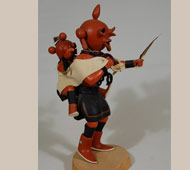 Koyemsi or Mudhead Katsinas are probably the most well-known of all the Hopi Katsinas. They appear in almost every Hopi ceremony as clowns, interlocutors, announcers of dances, drummers, and many other roles. They nearly always accompany other katsinas; probably the only time when they do not appear with other personages is during the Night Dances. They serve religious and secular functions. They function as chiefs during the season called Kwiyamuya, and as clowns at other times.
Koyemsi or Mudhead Katsinas are probably the most well-known of all the Hopi Katsinas. They appear in almost every Hopi ceremony as clowns, interlocutors, announcers of dances, drummers, and many other roles. They nearly always accompany other katsinas; probably the only time when they do not appear with other personages is during the Night Dances. They serve religious and secular functions. They function as chiefs during the season called Kwiyamuya, and as clowns at other times.
Koyemsi are usually the ones that play games with the audience to the accompaniment of rollicking tunes. These games are generally guessing games, or simple attempts to balance objects or performances of some common act. The rewards are prizes of food or clothing. It is obvious in this carving of the Mudhead, they are clowning around.
It has been stated that Koyemsi, with the knots on their heads, represent a deformity due to incest and the purpose is to portray to Hopi the results of such an action.
Masks used by Mudhead Katsinas are different in that they are made from fabric rather than formed from saddle leather as other katsina head coverings. The fabric from which one is formed traditionally is white cotton and it is covered in a mineral pigment to make it appear to be mud.
This katsina doll pair was sent to us by a consignor in 1980 to sell, which we did to a client of ours in Texas, who passed away last year, and now we have it to sell again. We know it dates to pre-1980. It is signed on the underside Mud Heads Hopi Roy Fredericks Winslow Ariz.
Condition: original condition
Provenance: from the estate of Michael Frost
Subject: Hopi Piggyback Koyemsi (Mudhead) Katsina Dolls
Artist / Carver: Roy Fredericks
Category: Traditional
Origin: Hopi Pueblo
Medium: cottonwood root, paint, fabric, feather
Size: 14" tall
Item # C3360W
Subject: Zuni Three-strand David Tsikewa Fetish Necklace
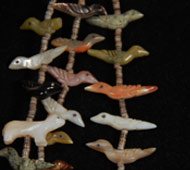 David Tsikewa brought a previously unseen delicacy to the art of fetish carving. His pieces have a sweet, gentle quality that distinguishes them from the works of his contemporaries. Born in 1915, David passed away from a heart attack in 1970. Tsikewa learned silversmithing from the renowned Horace Iule in about 1937 and by the mid-1940s was carving small fetishes for necklaces at the request of Ruth Kirk of the well-known Gallup, NM trading family. Although he continued silversmithing, he began focusing on carving fetishes by the mid-1950s.
David Tsikewa brought a previously unseen delicacy to the art of fetish carving. His pieces have a sweet, gentle quality that distinguishes them from the works of his contemporaries. Born in 1915, David passed away from a heart attack in 1970. Tsikewa learned silversmithing from the renowned Horace Iule in about 1937 and by the mid-1940s was carving small fetishes for necklaces at the request of Ruth Kirk of the well-known Gallup, NM trading family. Although he continued silversmithing, he began focusing on carving fetishes by the mid-1950s.
According to fourth-generation Indian trader Joe Tanner of Gallup, Tsikewa and Leekya Deyuse were the top of the heap of fetish carvers in the last half of the 20th century. Tanner and Santa Fe dealer Marti Struever both independently identified this necklace as that of David Tsikewa. In 1966, Tsikewa's fetishes were prominent at the Heard Museum's Zuni Show.
The delicate fetishes in this necklace, which number 33 per strand for three strands, were carved from a variety of stones and shell and the brown hieshe was handmade from shell. There are birds and animals of a variety of styles. The three strands are secured at the ends with silver cones and a handmade silver clasp. Tsikewa's fetishes, once $1 each, now command as much as $100 each.
Condition: original condition
Provenance: from the personal collection of Margaret Gutierrez of Santa Clara Pueblo
Subject: Zuni Three-strand David Tsikewa Fetish Necklace
Artist: David Tsikewa (1915-1971)
Category: Necklaces
Origin: Zuni Pueblo
Medium: stone, shell, silver
Size: 28" end-to-end
Item # C3371A
Subject: Black and Sienna Pictorial Plate by Tony Da
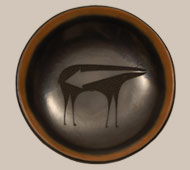 Tony Da, from San Ildefosno Pueblo, was destined to become one of the finest artists of the 20th century. His grandparents, Maria and Julian Martinez, and his father, Popovi Da, were skilled artists. Tony was a painter from early in life, and was winning awards for his paintings. A change occurred when he moved in with his grandmother in 1966. She taught him the techniques of pottery making and he learned very well. Within three years, Maria said he had nothing else to learn from her.
Tony Da, from San Ildefosno Pueblo, was destined to become one of the finest artists of the 20th century. His grandparents, Maria and Julian Martinez, and his father, Popovi Da, were skilled artists. Tony was a painter from early in life, and was winning awards for his paintings. A change occurred when he moved in with his grandmother in 1966. She taught him the techniques of pottery making and he learned very well. Within three years, Maria said he had nothing else to learn from her.
Once Tony started making pottery, his creativity blossomed. He followed all the traditional techniques Maria had taught him, but he matured as an artist in departing from traditional shapes and designs. He was fond of the Mimbres culture and used its designs on much of his work.
Tony's first pottery pieces were bears. Maria commented that he was very good and she could not do anything to make him better, except that he needed to learn to make ollas, which, of course, he did. In 1982, Tony suffered massive head injuries in a motorcycle accident, which left him unable to continue his pottery career. Fortunately for us, he left a legacy of outstanding art objects.
This black and sienna plate is a truly breathtaking and superlative design, with a Mimbres-style deer boldly placed in the center. It is a masterpiece of design and execution, a piece worthy of the Da name. Coil formed in native San Ildefonso clays, slipped, and stone-polished to a surface of the utmost quality, this plate was then fired in a non-oxidation firing to achieve the lovely deep black coloration. The sienna rim and sgraffito design were achieved after the firing, utilizing the sharpest attention to detail and superb technical ability to create motif and patterning of such intricacy, delicacy, and great beauty.
Condition: in superb original condition and signed on the underside with his hallmark. It was probably made in the 1970s.
Provenance: from the estate of Michael Frost
Recommended Reading: The Life and Art of Tony Daby Charles King and Richard Spivey
Subject: Black and Sienna Pictorial Plate by Tony Da
Artist / Potter: Tony Da 1940-2008
Category: Contemporary
Origin: San Ildefonso Pueblo
Medium: Native clay and slip
Size: 6-1/2" diameter
Item # C3360C
Biography: Margaret Maria Tafoya (1904-2001)
Margaret Tafoya (1904-2001) Maria Margarita Tafoya - Corn Blossom was the last of the matriarchs of the early 20th century pueblo potters. Born August 13, 1904 at Santa Clara Pueblo, Margaret learned her skills from her parents, Sara Fina Gutierrez Tafoya and Jose Geronimo Tafoya, who were expert potters; some of her pieces are inspired by tales she heard from her parents and grandparents. Margaret and her mother were known for their ability to make unusually large storage jars and water jars. She was married to husband Alcario Tafoya (1900 - 1995).
Tafoya's trademark is polished blackware. Her work is often decorated with bear paw designs, which she considered good luck. She is considered a master of the art of pottery making and made deeply carved blackware and redware vessels which are highly valued by collectors. She believed the secret to her technique were her polishing stones, which have been passed down through the generations. She taught her children (9 kids in total) her pottery-making skills to include: Virginia Ebelacker, Mela Youngblood, Toni Roller, LuAnn Tafoya, and Esther Archuleta. For a more complete family tree, see below (Reference: Pueblo Indian Pottery: 750 Artist Biographies: Santa Clara, San Ildefonso, San Juan, Tesuque, Nambe and Pojoaque. Gregory Schaaf. Family Tree 1, page 137).
A National Heritage Fellow, National Endowment for the Arts Folk Arts Program (1984). In 1985, Margaret Tafoya was one of three New Mexicans selected to receive the Governors Award, New Mexico's highest artistic honor, awarded for a major contribution to the arts of New Mexico.
Margaret Tafoya passed away during the night on February 25, 2001.
Biography: Margaret Maria Tafoya 1904-2001
Note: Click here to view Magaret Tafoya's Family Tree.
Subject: Santa Clara Pueblo Red Carved Canteen with Stopper
![Santa Clara Pueblo Red Carved Canteen with Stopper Starting sometime in the early 1950s, Margaret Tafoya made smaller bowls, jars, candlesticks and canteens for sale to tourists visiting the pueblo as well as to take to Royal Gorge for the summer. She and her family spent their summers—from Memorial Day to Labor Day—at the Royal Gorge near Canon City, Colorado, selling pottery and entertaining the tourists with dances and permitting them to photograph the family members—all for a fee. She had made enough pottery before going to Royal Gorge to take with her to sell. She did not make pottery on site. It was during the 1950s that pueblo pottery underwent a revival in interest by collectors and tourists. Following the lean years of World War II, both from a buyer's standpoint and that of the seller, as well, the 1950s saw a renaissance. Americans had sacrificed during the war, skimping and saving for the war effort and now gasoline and tires were again available and travel was possible. The Southwest was once again of interest and New Mexico saw a tremendous influx of tourists willing and anxious to purchase souvenirs to take back home. Fortunately for the pueblo potters, there was great interest in their pottery. This small red carved canteen with a wood stopper is typical of many that found their way out of the Southwest and into collections from coast to coast. It is a marvelous canteen and is beautifully designed with a stylized bird on one side and a kiva step design on the opposite. A leather strap is inserted into the loop handles and a wood stopper is provided for the opening. Condition: original condition with one minor scratch Provenance: from a family estate from Kentucky Recommended Reading: Born of Fire: The Pottery of Margaret Tafoya [SOLD] by Charles King](https://www.adobegallery.com/uploads/C3379C-thumb.jpg) Starting sometime in the early 1950s, Margaret Tafoya made smaller bowls, jars, candlesticks and canteens for sale to tourists visiting the pueblo as well as to take to Royal Gorge for the summer. She and her family spent their summers-from Memorial Day to Labor Day-at the Royal Gorge near Canon City, Colorado, selling pottery and entertaining the tourists with dances and permitting them to photograph the family members-all for a fee. She had made enough pottery before going to Royal Gorge to take with her to sell. She did not make pottery on site.
Starting sometime in the early 1950s, Margaret Tafoya made smaller bowls, jars, candlesticks and canteens for sale to tourists visiting the pueblo as well as to take to Royal Gorge for the summer. She and her family spent their summers-from Memorial Day to Labor Day-at the Royal Gorge near Canon City, Colorado, selling pottery and entertaining the tourists with dances and permitting them to photograph the family members-all for a fee. She had made enough pottery before going to Royal Gorge to take with her to sell. She did not make pottery on site.
It was during the 1950s that pueblo pottery underwent a revival in interest by collectors and tourists. Following the lean years of World War II, both from a buyer's standpoint and that of the seller, as well, the 1950s saw a renaissance. Americans had sacrificed during the war, skimping and saving for the war effort and now gasoline and tires were again available and travel was possible.
The Southwest was once again of interest and New Mexico saw a tremendous influx of tourists willing and anxious to purchase souvenirs to take back home. Fortunately for the pueblo potters, there was great interest in their pottery.
This small red carved canteen with a wood stopper is typical of many that found their way out of the Southwest and into collections from coast to coast. It is a marvelous canteen and is beautifully designed with a stylized bird on one side and a kiva step design on the opposite. A leather strap is inserted into the loop handles and a wood stopper is provided for the opening.
Condition: original condition with one minor scratch
Provenance: from a family estate from Kentucky
Recommended Reading: Born of Fire: The Pottery of Margaret Tafoya by Charles King
Subject: Santa Clara Pueblo Red Carved Canteen with Stopper
Artist / Potter: Margaret Maria Tafoya 1904-2001
Category: Contemporary
Origin: Santa Clara Pueblo
Medium: clay, leather, wood
Size: 4-1/4" tall without stopper x 5-3/8" wide
Item # C3379C
Subject: Ohkay Owingeh Pueblo Potsuwii'i Incised Revival Bowl
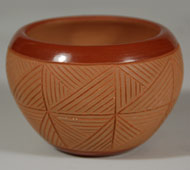 By 1890, pottery production at San Juan Pueblo (now Ohkay Owingeh Pueblo) had come to a complete halt. In 1930, Regina Cata organized a pottery study group with the intent of reviving pottery production. Eight potters studied ancient potsherds of wares made at San Juan in earlier times and selected Potsuwii'i Incised Ware (1450-1500) as a basis for contemporary pottery type. Decorative zones of geometric fine lines with selected areas of polished red slip were the final result.
By 1890, pottery production at San Juan Pueblo (now Ohkay Owingeh Pueblo) had come to a complete halt. In 1930, Regina Cata organized a pottery study group with the intent of reviving pottery production. Eight potters studied ancient potsherds of wares made at San Juan in earlier times and selected Potsuwii'i Incised Ware (1450-1500) as a basis for contemporary pottery type. Decorative zones of geometric fine lines with selected areas of polished red slip were the final result.
This bowl by Rosita De Herrera is a fine example of contemporary Ohkay Owingeh Incised Ware. Micaceous slip decorates the incisions. Rosita learned from her mother, Tomasita Montoya, who was one of the original eight potters. She is a sister of Dominguita Naranjo who is also a potter who was mentored by her mother, Tomasita.
Condition: original condition
Provenance: from a family estate from Kentucky
Subject: Ohkay Owingeh Pueblo Potsuwii'i Incised Revival Bowl
Artist / Potter: Rosita De Herrera (ca.1940)
Category: Contemporary
Origin: Ohkay Owingeh Pueblo (San Juan)
Medium: clay
Size: 2-7/8" deep x 4-1/4" diameter
Item # C3379B
Biography: Paqua Naha (1890-1955) Frog Woman
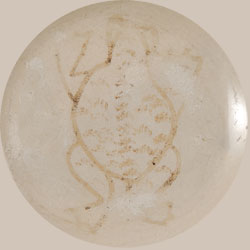 Paqua Naha was the original Frogwoman and the mother of Joy Navasie, the current Frogwoman. She was born around 1890 and passed away in 1955. Paqua, which means Frog, signed her pottery with a frog hallmark. Her hallmark is distinguishable from her daughters because she used straight-line feet and Joy uses webbed feet. She was an outstanding and well-respected potter throughout her entire productive life.
Paqua Naha was the original Frogwoman and the mother of Joy Navasie, the current Frogwoman. She was born around 1890 and passed away in 1955. Paqua, which means Frog, signed her pottery with a frog hallmark. Her hallmark is distinguishable from her daughters because she used straight-line feet and Joy uses webbed feet. She was an outstanding and well-respected potter throughout her entire productive life.
Paqua, for most of her career, produced polychrome decorated wares on a yellow or cream slip. It was not until the last three years of her life that she developed the white ware that is so closely associated with the Frogwoman family of potters.
Biography: Paqua Naha (1890-1955) Frog Woman
Subject: Polychrome Bowl With Palhik Mana Design by Frog Woman
It is most unusual to see a bowl by Paqua Naha with a Palhikmana Katsina face as decoration. I don't recall ever seeing one before. Paqua Naha was the original Frog Woman (1890-1955) and the mother of Joy Navasie, the second Frog Woman (1919-2012). This bowl is decorated inside and out. The exterior is a variety of geometric designs, including rain and clouds. The interior shows the face of the Palhikmana Katsina on the bottom of the bowl and the tableta around the wall of the bowl above her face and her dress around the wall below her face.
Condition: structurally in excellent condition, with some minor abrasion to the exterior design.
Provenance: from the collection of an Oregon client
Recommended Reading: Hopi-Tewa Pottery: 500 Artist Biographies [1st ED/1st Print:] by Gregory and Angie Schaaf
Subject: Polychrome Bowl With Palhik Mana Design by Frog Woman
Artist / Potter: Paqua Naha (1890-1955) Frog Woman
Category: Contemporary
Origin: Hopi Pueblo
Medium: Native Clay, Slip and Paint
Size: 4-1/4" tall by 8-1/2" diameter
Item # C3378A


![Bronze Sculpture of Eototo and Aholi Katsinas “Morning Prayers” On another planet at another time, some say, Eototo and Aholi were inseparable friends. The two personalities retain that proximity as Hopi Katsinas and continue to work together at ceremonies that link the earth and its inhabitants with other forces in the universe. Eototo is chief among the katsinas. With his second-in-command Aholi, he played a historically vital role in the great 17th century pueblo revolt. Quintessentially Hopi, each nonetheless possesses attributes or characteristics that seem to echo those of other religions' saints or priests. Aholi's cone-shaped head and staff recall the appearance of Christian bishops in ceremonies and Aholi's repeated chanting of his own name resembles the rhythms of a different liturgy. These non-coincidental cultural reverberations blend mockery and tribute with an overwhelming Hopi sense of the inter-connectedness of all things. The limited edition bronze sculptures of Lowell Talashoma, Sr. are the manifestations of an artistic eye and vision that spans two cultures, for Lowell is unusual in having spent many of his childhood years in the care of foster parents who raised him in a mainstream Mormon home. Becoming Hopi meant for Lowell accepting a new reality and set of beliefs as well as coming to understand the traditions, ceremonies, languages and social customs implicit in his choice. Giving form to this historically-rich culture is a task Lowell set for himself with pleasure and excitement; what is ancient and inherently true to the Hopi people is newly rediscovered and revered through Lowell's dawning awareness of what it is to be Hopi. Each form and figure tells a story as does the process Lowell employed in its creation. His images were inspired by Hopi beliefs and were "liberated" from cottonwood root—the Hopi traditional carving material—through his vision of what lies within. Although he could have worked faster in preparation for bronzing by using wax or clay, Lowell preferred to interact with the wood, a material he respected for its life character. The castings made from his carvings via the lost wax method retain that spirit. This bronze sculpture of Aholi and Eototo Katsinas was cast in 1982 by the lost wax method in an edition of 35 of which this is number 1. Condition: original condition Provenance: from the estate of a California family. There are six bronze katsina sculptures by Lowell Talashoma in this estate which all are numbered 1 of 35. The family apparently had connections with the foundry to acquire the first casting of each of the six. The others which are available are shown below in related items of interest. Recommended Reading: Beyond Tradition: Contemporary Indian Art and Its Evolution [Paperback Edition] by Lois Jacka, et al.](https://www.adobegallery.com/uploads/C3365F-bronze.jpg)
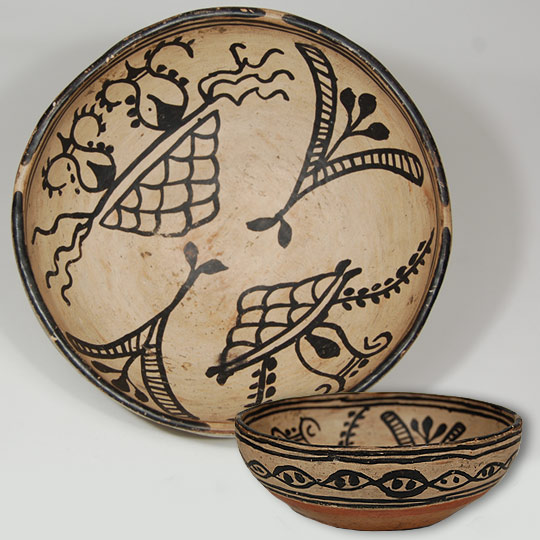
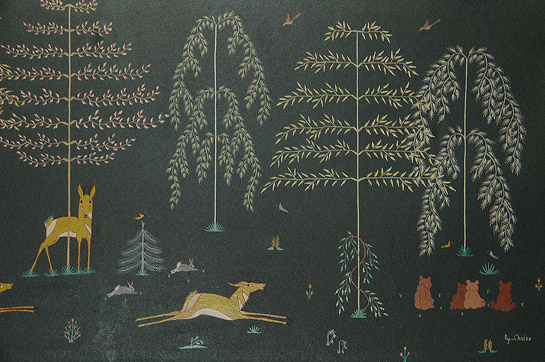
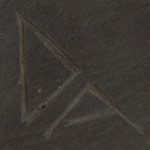
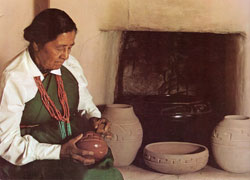
![Polychrome Bowl With Palhik Mana Design by Frog Woman It is most unusual to see a bowl by Paqua Naha with a Palhikmana Katsina face as decoration. I don't recall ever seeing one before. Paqua Naha was the original Frog Woman (1890-1955) and the mother of Joy Navasie, the second Frog Woman (1919-2012). This bowl is decorated inside and out. The exterior is a variety of geometric designs, including rain and clouds. The interior shows the face of the Palhikmana Katsina on the bottom of the bowl and the tableta around the wall of the bowl above her face and her dress around the wall below her face. Condition: structurally in excellent condition, with some minor abrasion to the exterior design. Provenance: from the collection of an Oregon client Recommended Reading: Hopi-Tewa Pottery: 500 Artist Biographies [1st ED/1st Print:] by Gregory and Angie Schaaf](https://www.adobegallery.com/uploads/C3378A-bowl.jpg)